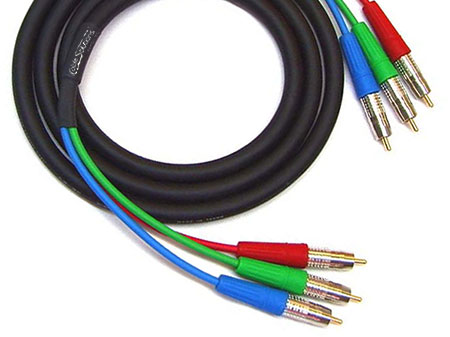
Canare V3-3C Jacketed Component Video Cable
Pro Series 3-Channel Precision Cable with RCA or BNC Connectors
Canare V3-3C Jacketed Component Video Cables feature Canare's high-quality precision cable terminated with Canare's, "True 75 Ohm" connectors.
Flexible color-coded silicone strain-relief boots enhance the appearance of the cables and avoid sharp bends at the connectors while providing visual identification of the channels.
This mid-sized, multi-channel cable is a perfect choice for shorter runs, where the appearance of a single cable jacket is preferable to that of multiple discrete cables. The smaller profile makes for a highly flexible cable, with outstanding flex life, making it ideal for portable installations or for routing behind your equipment. Performance is excellent, nearly equaling that of Canare LV-61S, and far exceeding that of most consumer-grade component video cables.
If you are not sure which component cable to choose, please click here for a comparison of Canare component video cables.
Why Component?
In a word, simplicity. Component video hook-ups eliminate some encoding and decoding steps. This is likely to improve picture quality because encoding or decoding a color signal is not a very clean process. Invariably some information is lost, and undesirable artifacts such as chroma crawl, busy edges, loss of detail in colored areas, and cross-color rainbows are generated. Each pass through the process adds to the problem, so the fewer times a signal is encoded and decoded, the better. If your equipment supports component video connections, you will certainly want to take advantage of it.
What Makes Canare So Great?
You can tell by looking that Canare cables and connectors are well made, and you can tell by reading the rave reviews that Canare cables are great performers! Canare is the choice of professionals and discriminating enthusiasts, alike.
In our experience, the key to great video cables is in the connectors. Exotic conductors and shielding are fine, but it's the connectors that really make the difference.
The Monster brand is very popular, but from reading their website, at the time of this writing, we cannot not see that they even claim to be using constant impedance connectors on their cables. Tributaries, StraghtWire, MIT, AudioQuest...I know you've seen the ads...most of the advertising looks more like superstition than science. It's all very confusing, because a higher price does not necessarily equate to better performance, and most of the "technical data" on high-end cables is just a bunch of mumbo-jumbo, with little or no basis in fact. Unfortunately, superlatives do not render a superior picture. In fact, in our own testing, no cable (at any price) has outperformed a similarly sized Canare cable. Even this mid-sized Canare cable stands up very well against larger, and much more expensive cables from other manufacturers.
Canare RCA Connectors
It is hard to imagine a finer RCA connector than Canare's. They are precision machined to maintain a constant 75 ohm impedance. We install them using a Canare tool which always prepares the cable ends, just right. The connectors are crimped in place, using heavy, precision-machined dies. The crimps are so tight that oxygen is excluded, and thus corrosion is prevented. It's an awesome system, and the resulting terminations are in a class of their own.
Ironically, the most common connector used for interconnecting consumer A/V gear may also be the worst connector in general use today. Generic RCA type audio plugs and cables have been around since the 1940s, but the old solder-type plugs typically have an impedance of about 25 ohms. As a result, they exhibit extremely poor return loss performance, even when mated to high quality cable. Some of the most expensive "high end" cables still rely on connector designs that are both electrically and mechanically inferior.
Canare's "True 75 Ohm" RCA crimp plugs solve these problems. They are impedance matched to achieve excellent performance in both digital and analog applications. They have a usable bandwidth of over 200 MHz and VSWR is typically less than 1.1:1 from DC to 200 MHz! This low standing wave ratio minimizes reflected signals for maximum signal transfer and clear sound.
If you look at the picture at the right, you can see the gold-plated center shaft. If you click on the picture, you can get a better look at the internal gold-plated beryllium copper pressure fingers. The design ensures good contact, while solving the "grip of death" problem that can be an issue with Monster and some of the other manufacturers' connectors. (Those "grip of death" connectors put unnecessary strain on your equipment!) Canare connectors connect up smoothly, and maintain good contact, while protecting your equipment investment.
Canare BNC Connectors
The BNC-type connector is the best connector that is commonly available for applications of this type. In general, it is both mechanically and electrically superior to an RCA connector. It has a twist-lock mechanism to ensure that the connection is mechanically secure, and the electrical design of the connector does a good job of maintaining constant impedance at the connector.
Canare takes this inherent superiority to the next level. For example, many BNC connectors have a characteristic impedance of only 50 ohms, but Canare connectors are engineered to maintain a constant impedance of 75 ohms. This make a lot of sense because virtually all A/V equipment is designed to work best with 75 ohm cables. It follows that if you want the best performance your equipment can deliver, you will need cables and connectors that maintain this impedance.
This electrical superiority is the result of superior mechanical design, high-quality materials and precision manufacturing. Canare's BNC connectors are almost artful in their design...and they work very well indeed.
Cable Specs
Of course you also want high quality cable. Flexibility is desirable because it avoids stress on your equipment and the interconnects. Flex life is important because it prevents cable performance from degrading over time. Try to avoid multiple materials in the conductors or shielding, because of the problems associated with dissimilar metals. Low loss is desirable, but don't sacrifice mechanical integrity in favor of small differences in loss specs! Cables with foamed dielectric materials generally have lower loss, but foam is not without it's own inherent problems. Shielding is important, but don't be confused by exorbitant claims. Electrical shielding is not the same as waterproofing -- you don't need two, three, four, or more layers of shielding to get good electrical shielding. All the extra layers make the cables stiff, and tend to make good terminations more difficult to install, and more prone to failure.
This three-channel Canare cable is lightweight and extremely flexible. Considerably more flexible than the Monster cables we tested. It has a PVC jacket with a smooth, non-glare finish, and it stays flexible even at sub-zero temperatures! Here are some specs on the cable:
- Outside jacket diameter, 11.5 mm (.453 in.)
- Individual channel OD, 4.4 mm (.173 in.)
- Low loss - less than .015 dB per meter at 1 MHz, and less than .49 dB even at 1 GHz!
- Tightly woven all-copper shield with greater than 97% coverage
- Nominal capacitance, 67 pF per meter
- Nominal impedance, 75 ohms
- Velocity of propagation, 66%
- Less than 2.2 nanosecond differential delay between channels
Flawless Results
Here's what you need if you want the finest video that your equipment can deliver. You need video cables that are capable of maintaining a constant impedance. You don't want any bumps at the connectors, and you don't want the cable itself to change impedance when it bends. Even the finest cable changes impedance a little bit when it is bent sharply, so avoid doing so. Nice, smooth, consistent, 75 ohm impedance. That's what your equipment wants, and that's what will deliver the best picture.
You also want superior mechanical integrity. Nice, tight connections that will not degrade over time. You want to avoid dissimilar metals, which can lead to corrosion and degrade connections. To avoid dissimilar metals, try to stay away from soldered connections wherever you can, because solder almost guarantees that dissimilar metals will be in contact. Good solder work minimizes the problem, but there is also the challenge of making a solder connection without heat deforming the dielectric material of the cable. Any dimensional change in the dielectric will affect the impedance of the cable at that point.
See For Yourself !
We have tested these Canare cables against Monster, and some other more esoteric cables. In our test setup, no other cable outperformed a Canare cable of a similar size. If you don't believe it, you can try it yourself. If you don't already have it, get a copy of the Video Essentials or Avia test disks for your DVD or laserdisc player, and take a look at the test patterns. Watch for the artifacts mentioned above that can creep in with lesser cables, then switch to the Canare cables and look for the difference that constant impedance can make. We tested cables ranging in length from 1 meter to 100 meters. Some of the cables that we tested had specs that looked better on paper than Canare's, but our my real-world tests, Canare always prevailed.
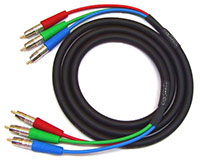
This picture shows a 3 meter cable - please select the length that you need below.
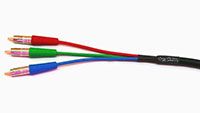
Here is a closer look at the end preparations.

Here is a closer look at the RCA connectors. The green, blue and red silicone strain-relief boots provide industry-standard color-coding for quick and easy hook-up.
Our "standard" connectors are RCA, as shown here, but you may also choose Canare's high-performance BNC connectors - you can customize your connector preferences below.
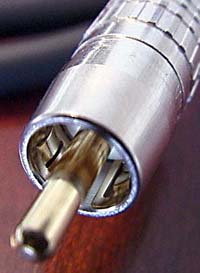
This close-up will give you a good look at the internal gold-plated beryllium copper pressure fingers and gold-plated center shaft that are unique to Canare's amazing "True 75 Ohm" impedance-matched RCA connectors.
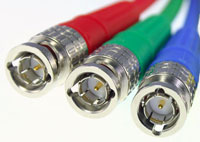
Shown here are the optional BNC connectors. Notice the heavy connector bodies and gold-plated pins.
Why Cable Solutions?
- Customer service is our first priority. We do our best to help you find the best solutions for your particular application. We're enthusiasts too, so we know what it's like to wait for cables to hook up new gear. We stock all of the components needed to build these cable assemblies, so we are able to do something that most cable shops do not - we build and ship most orders within one business day.
- It takes outstanding people to produce the kind of workmanship you want for your custom cables, and in all modesty, we have some outstanding people! We'll let you figure out for yourself why paying too little for a cable can turn out to be just as bad as paying too much.
- The importance of high-quality workmanship is second only to the importance of superior service. If you have had enough of outsourced support or worse yet, companies that do not even publish a a functional phone number or email address, we think you will be absolutely delighted that you found our company. We know how important it is to be able to get help when you need it. That's why we have people, right here in Texas, ready to respond to your email or answer your phone call. If English is your language of choice, you will have the simple pleasure of communicating with people whose first language is English. Granted, if you call on the phone, you may detect more than a trace of a Texas accent, but that is to be expected when dealing with a family-owned business run by native Texans. We sincerely hope that you will find our heritage of courtesy, honesty, doing business in an ethical way to be a refreshing experience.
The best cable, the best connectors, and one of the finest solders available...when you take a system this good and put it in the hands of technicians as good as ours, it becomes an awesome system! Design excellence, high quality materials, meticulous workmanship, and superior service...put it all together and you get a superior product. Don't get stuck with bad advice, poor service, slow shipment or an inferior product. If you want the best, here it is!

